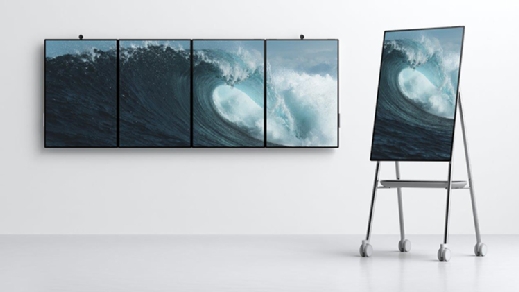
Fotolia
Microsoft hopes for smooth rollout of Surface Hub 2 after previous snags
The Surface Hub 2 will feature tight integrations with Microsoft Teams and other cloud collaboration tools. The vendor plans to release the product in 2019.
Microsoft plans to release a new version of its Surface Hub digital whiteboard and meeting room display sometime in 2019. The vendor said it designed the second-generation device with the primary goal of making it easier for teams to get work done.
The Surface Hub 2 will integrate with Microsoft Teams, the cloud-based team collaboration platform that will soon replace Skype for Business Online, as well as Office 365, Windows 10 and Microsoft Whiteboard. The touchscreen display comes with 4K cameras, speakers and far-field microphones.
The vendor twice postponed the release of the original product because of manufacturing issues. And it raised the price by $2,000 amid those delays. Originally promised for fall 2015, the Surface Hub wasn't delivered until spring 2016.
At 50.5 inches, the second-generation device will be slightly smaller than the original, but Microsoft has not yet revealed how much it will cost. The 55-inch, first-generation Surface Hub costs roughly $9,000, while the 84-inch version costs nearly $22,000.
Multiple users can sign in to Surface Hub workspaces at the same time, so teams can collaborate on files and presentations stored in the cloud. A promotional video depicts workers using PCs and the Surface Hub 2 to simultaneously work on the same document.
The video highlighted the ability to rotate the displays between vertical and horizontal presentations and push up to four of the devices together to form one large screen. A fingerprint sensor on the side of the device will facilitate logins.
Microsoft will make the Surface Hub 2 available to a select group of commercial customers for testing later this year, before the device goes on sale in 2019. The product will compete with digital whiteboards such as the Google Jamboard and the Cisco Webex Board.

Many customers don't take full advantage of digital whiteboards
Microsoft said it has sold Surface Hubs to more than 5,000 customers, including half of Fortune 100 companies. But, inside many organizations, the devices are used primarily as a monitor, akin to a TV with an HDMI port, analysts said.
"I think a lot of organizations found it difficult to use, so they weren't really leveraging all of its capabilities," said Andy Howard, founder and managing director of the consultancy Howard & Associates. "In that case, it just ends up turning into a big, extraordinarily expensive display."
Because the learning curve for some of these new collaboration technologies is so steep, vendors like Microsoft and Cisco are trying to design user interfaces that are consistent across devices, Howard said. The integration of Microsoft Teams with the Surface Hub 2 should make the device seem familiar to users.
Microsoft customers are also hoping the vendor improves the Surface Hub's video conferencing capabilities. Many users complained about the quality of the original device's cameras, Howard said. "A lot of people were using third-party cameras, in addition to the Surface Hub."
Microsoft targets the meeting room experience
The original Surface Hub was a good piece of hardware, but it was essentially just another vehicle for bringing the Windows operating system into the conference room, said Ira Weinstein, managing partner of Recon Research Inc., based in Coral Springs, Fla.
In the time since the Surface Hub's release, however, Microsoft seems to have developed a greater appreciation for the importance of meeting rooms. "What they are trying to do now is improve your productivity, make your time more valuable," Weinstein said. "That's the next level."
At the Microsoft Build conference earlier this month, the vendor showcased its vision for meeting rooms of the future. The demo included a 360-degree camera for video conferencing, automatic recognition of meeting attendees as they entered the room, and the use of artificial intelligence to transcribe meetings and identify items requiring follow-up.
Microsoft has historically partnered with a range of hardware vendors, such as Logitech and Polycom, to provide endpoints for its collaboration services. But the new whiteboard product should appeal to enterprises that are looking for the simplicity of a one-vendor collaboration environment.
It will also give Microsoft channel partners a tangible piece of hardware to sell alongside cloud subscriptions, said Jon Arnold, principal of Toronto-based research and analysis firm J Arnold & Associates.








